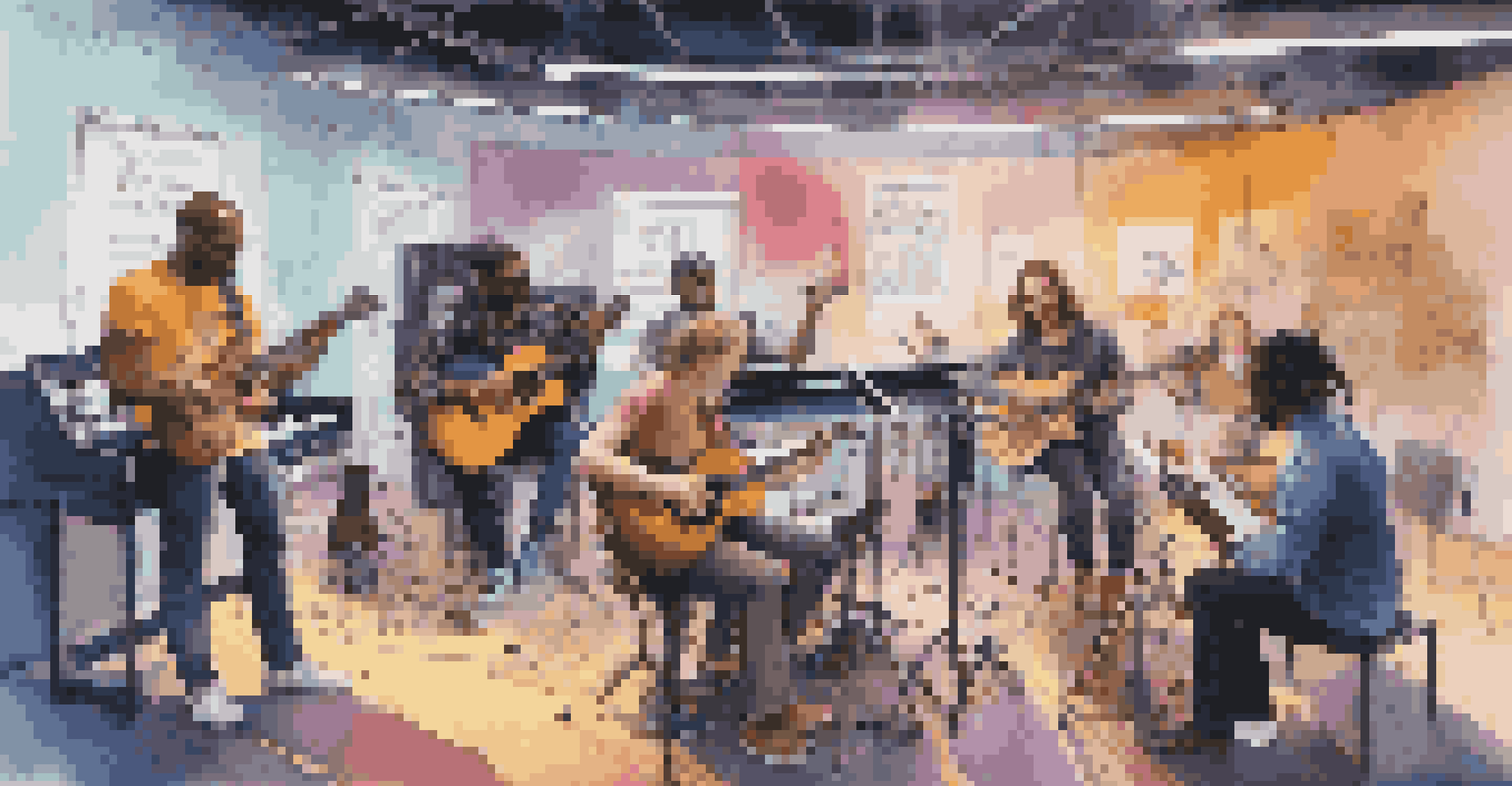The Connection Between Language Complexity and Musical Composition

Understanding Language Complexity in Music Composition
Language complexity refers to how intricate and nuanced language can be, involving vocabulary, syntax, and semantics. In musical composition, similar principles apply; composers often manipulate various musical elements to create depth and emotion. Just as a poet chooses their words carefully, a musician selects notes and rhythms that convey specific feelings or narratives.
Music can change the world because it can change people.
For example, a simple melody might evoke joy, while a complex interplay of harmonies can express tension or conflict. This relationship illustrates how both language and music serve as forms of communication, each with their own set of rules and structures. By examining these parallels, we can appreciate how composers craft their pieces with as much thought as a writer chooses their phrases.
Ultimately, recognizing language complexity in music helps us understand the artistry behind compositions. It shows us that music, like language, is not merely about sound but also about meaning and expression. This connection invites listeners to engage more deeply with what they hear.
The Role of Syntax in Musical Composition
Syntax in language refers to the arrangement of words to form coherent sentences. In music, this concept translates to the arrangement of notes and rhythms to create structured compositions. Just as a well-formed sentence enhances clarity in writing, a well-structured musical phrase enhances the listener's experience.

Consider a sonnet's rhyme scheme; it's meticulously designed to evoke emotion and rhythm. Similarly, in a symphony, the way themes are introduced and developed leads to a satisfying listening experience. This structured approach allows composers to play with expectations, providing surprises that keep audiences engaged.
Music and Language Share Complexity
Both music and language use complex structures to convey deep emotions and meanings, highlighting their artistic similarities.
When composers break these 'musical syntax' rules, they often create innovative pieces that challenge traditional forms. This mirrors how poets sometimes twist language norms to create unique effects. Understanding the syntax in music helps us appreciate the craftsmanship involved in composition.
Melody and Vocabulary: A Comparative Analysis
Vocabulary in language consists of the words we use, while melody in music is made up of the notes and pitches that form a song. Just as a rich vocabulary allows for diverse expression, a varied melody can evoke a wide range of emotions. Composers often draw from a 'musical vocabulary' to create memorable and impactful pieces.
Words can be like X-rays if you use them properly—they’ll go through anything. You read and you’re pierced.
For instance, a composer might use a specific set of notes to convey a theme, similar to how a writer might repeatedly use certain words to drive home a point. This repetition can create familiarity and resonance for the audience. Therefore, both language and melody work to establish a connection with the listener, inviting them into the narrative.
Furthermore, just as new words can be invented or borrowed in language, composers often experiment with unconventional melodies. This exploration pushes the boundaries of both fields, demonstrating the endless possibilities of expression that arise from creativity.
The Emotional Resonance of Complex Structures
Both language and music have the power to evoke emotions, and this resonance often arises from complexity. In literature, complex character development can lead to deep emotional engagement, while in music, intricate harmonies or unexpected chord progressions can stir similar feelings. This interplay of complexity creates a richer experience for the audience.
For example, a novel's plot twist can leave readers breathless, just as a sudden shift in a musical piece can elicit surprise or joy. The emotional depth achieved through complex structures encourages audiences to reflect on their own experiences and feelings. This connection between emotional resonance and complexity is a vital aspect of both language and music.
Cultural Influences Shape Expression
Cultural backgrounds significantly impact the complexity of both language and music, enriching human expression across different societies.
Understanding how complexity enhances emotional expression allows us to appreciate both forms of art more deeply. It emphasizes the importance of thoughtful construction in crafting compelling narratives and compositions, reinforcing the idea that complexity can be beautiful.
Cultural Influences on Language and Music Complexity
Cultural background plays a significant role in shaping both language and music. Different cultures have unique linguistic structures, idioms, and musical scales that contribute to their complexity. For instance, tonal languages like Mandarin Chinese rely heavily on pitch to convey meaning, much like how certain musical traditions emphasize specific scales.
Similarly, the complexity of classical Western music can differ vastly from the improvisational styles found in jazz. Each cultural approach brings its own richness, influencing how language and music are perceived and created. This diversity allows for a more comprehensive understanding of human expression across different societies.
By exploring these cultural nuances, we can appreciate how language and music not only reflect personal emotions but also societal values. This perspective encourages a broader appreciation of both fields and highlights the intricate ways in which they intersect.
How Language and Music Influence Each Other
The interplay between language and music is fascinating, as they often influence one another in various ways. Lyrics in songs can enhance the emotional depth of music, while musical elements can shape the rhythm and flow of spoken language. This cross-pollination enriches both mediums, allowing for more nuanced expression.
Consider how a catchy melody can make lyrics more memorable; it’s an example of how music can elevate language. Conversely, a powerful spoken word performance can resonate with musicality, drawing on rhythm and intonation to convey meaning. This synergy highlights the importance of collaboration between musicians and poets.
Interplay Enhances Artistic Exploration
The reciprocal influence between language and music fosters innovative artistic expression, encouraging collaboration and creativity.
Ultimately, recognizing this influence encourages us to explore the boundaries of both art forms. By embracing the connections between language and music, we can cultivate a more profound appreciation for creativity in all its forms.
The Future of Language and Music in Composition
As technology advances, the future of language and music composition will likely become even more intertwined. Digital tools allow for experimentation and collaboration that was once unimaginable, enabling composers and writers to push boundaries. This evolution opens new avenues for creativity, blending genres and styles in exciting ways.
For instance, electronic music often incorporates spoken word elements, creating unique soundscapes that challenge traditional definitions of both music and poetry. This trend reflects a growing appreciation for the interconnectedness of art forms and the creative possibilities that arise from their fusion. It also highlights how the digital age encourages innovation and exploration.

As we look ahead, the ongoing dialogue between language and music will continue to shape artistic expression. By embracing this connection, creators can inspire new generations to engage with both mediums, ensuring that the legacy of language and music thrives in the future.